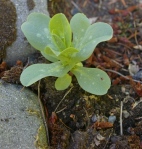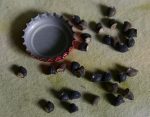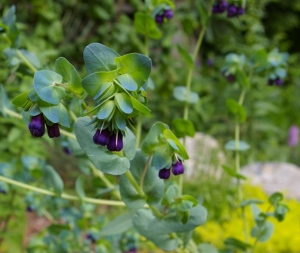The first time I spied this neat annual, my friend Kellie Dawson was growing it in her Port Orchard garden. She is quite fond of self-sowers–plants that reproduce freely and combine with other plants in delightful ways that she couldn’t herself have imagined. She loves cottage gardens and their informal look.
Cerinthe has many endearing features–the main one is that the flower bracts are stained blue and enclose rich purple tubular flowers. The foliage is fleshy, silvery gray with white mottling and combines in an ethereal way with the nodding flowers that range from sky to indigo to violet. In full sun, Cerinthe is a breeze to grow and bees are drawn to it; the name honeywort is derived from this fact. It doesn’t mind our dry summers, not surprising since it hails from the Mediterranean.
 Though I knew of this plant a decade ago, only recently did I try it. I am reluctant to embrace self-seeding plants, having been burned by a few bullies that I am still weeding from the garden today. Perhaps I am more of a control freak than other gardeners. It’s true that I’m no fan of deadheading and like to leave seeds for the birds.
Though I knew of this plant a decade ago, only recently did I try it. I am reluctant to embrace self-seeding plants, having been burned by a few bullies that I am still weeding from the garden today. Perhaps I am more of a control freak than other gardeners. It’s true that I’m no fan of deadheading and like to leave seeds for the birds.
I do have some short lived perennials and annuals that self-seed mildly. I don’t mind weeding out a few volunteers and leaving a few strategically placed seedlings to keep my feverfew, Italian parsley and yellow foxglove going. Cerinthe has joined the list of plants that I let spread themselves around.
 Two friends commented on the Cerinthe plants this year, so this week I collected seed. Normally I just let it ripen and drop into the beds and wait to see where they come up. But it can’t be any easier to propagate honeywort because the seeds are large and ripen progressively. That means that you can collect seed over a long time in summer. If you forget one week, you can still collect some seed off even the same plant a few weeks later. The big seed makes it easy to plant in pots or flats such that you don’t have to do a lot of thinning when the shoots pop up.
Two friends commented on the Cerinthe plants this year, so this week I collected seed. Normally I just let it ripen and drop into the beds and wait to see where they come up. But it can’t be any easier to propagate honeywort because the seeds are large and ripen progressively. That means that you can collect seed over a long time in summer. If you forget one week, you can still collect some seed off even the same plant a few weeks later. The big seed makes it easy to plant in pots or flats such that you don’t have to do a lot of thinning when the shoots pop up.
What I like best about growing plants from seed is the variability that can be seen from one plant to the next. When this year’s three Cerinthe plants started blooming in late spring, I noticed differences in coloration and form. One was more sprawling, the others more upright. Longer, deeper purple flowers were conspicuous on one and another had shorter, paler flowers, but brighter blue bracts. I’ll give my friends some seed, but I’m also going to plant a flat of seeds for myself just to make sure that I have enough Cerinthe in the garden into the future.
© Colleen Miko, 2012




